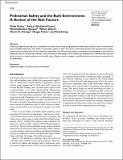| dc.contributor.author | Philip Stoker, Andrea Garfinkel-Castro, Meleckidzedeck Khayesi, Wilson Odero, Martin N Mwangi, Margie Peden, Reid Ewing | |
| dc.date.accessioned | 2020-08-10T07:46:13Z | |
| dc.date.available | 2020-08-10T07:46:13Z | |
| dc.date.issued | 2015-11 | |
| dc.identifier.citation | 65 | en_US |
| dc.identifier.uri | https://repository.maseno.ac.ke/handle/123456789/1911 | |
| dc.description.abstract | Urban and regional planning has a contribution to make toward improving pedestrian safety, particularly in view of the fact that
about 273,000 pedestrians were killed in road traffic crashes in 2010. The road is a built environments that should enhance safety
and security for pedestrians, but this ideal is not always the case. This article presents an overview of the evidence on the risks that
pedestrians face in the built environment. This article shows that design of the roadway and development of different land uses can
either increase or reduce pedestrian road traffic injury. Planners need to design or modify the built environment to minimize risk
for pedestrians. | en_US |
| dc.publisher | SAGE Publications | en_US |
| dc.subject | pedestrian safety, risk factors, built environment | en_US |
| dc.title | Pedestrian safety and the built environment: a review of the risk factors | en_US |
| dc.type | Article | en_US |

